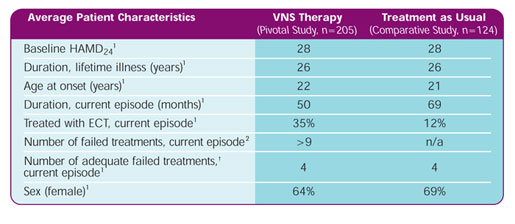|
VNS Therapy offers efficacy that improves over time and is sustained long term for many patients experiencing treatment-resistant depression.
Learn more about how VNS Therapy is studied in clinical studies
Baseline characteristics of patients enrolled in pivotal study1

*Hamilton Rating Scale of Depression, 24 items.
†n=104.
†All treatments met ATHF Antidepressant Treatment History Form criteria for adequate dose, duration, and peer—reviewed published data from a randomized controlled trial.
Efficacy with VNS Therapy improves over time and is sustained long term
At 12 months, response and remission rates were statistically significant across all major instruments used in measuring efficacy.1

*Inventory of Depressive Symptomatology Self-Report, 30-item.
† Clinical Global Impression-Improvement. Evaluable patient populations; observed data.
‡ Statistically significant. Pivotal Study: adjunctive VNS Therapy.
Comparative Study: active treatment as usual without VNS Therapy.
Patients with treatment-resistant depression showed significant improvement at 24 months3
- 17% of patients with TRD were free of depressive symptoms (remission)3
- 32% of patients with TRD achieved clinical response3
Efficacy of VNS Therapy improves over time3,4

*"Remission" defined as HAMD24 score ≤ 9 (symptom-free).
†"Response" defined as ≥ 50% reduction in HAMD24 score.
2-year outcomes confirm efficacy is sustained long term5

Percentage of HAMD24 responders (>50% improvement from baseline) who maintained response (>40% improvement from baseline).
A high percentage of patients with TRD who showed substantial clinical benefit after 3 and 12 months of VNS Therapy sustain benefits. Patients classified as early responders at 3 months, or late responders at 12 months, maintained improvement with VNS Therapy at 24 months. Of early responders, 63.3% and 76.7% maintained response at 12 and 24 months, respectively; of late responders, 65% maintained response at 24 months, indicating that once meaningful improvement is attained, there is a strong tendency to sustain the improvement.5
Learn more about how VNS Therapy is studied in clinical studies
Because VNS Therapy is a unique treatment option for TRD, the clinical studies are different from those conducted with medications.
Find out
how VNS Therapy clinical studies were conducted.
The safety and efficacy of this therapy have not been systematically established in patients with the following conditions: depression with a history of schizophrenia, schizoaffective disorder, or delusional disorders, depression with a history of rapid cycling bipolar disorder, cardiac arrhythmias or other abnormalities, history of dysautonomias, history of previous therapeutic brain surgery, history of respiratory diseases or disorders, including dyspnea and asthma, history of ulcers (gastric, duodenal, or other), history of vasovagal syncope, neurological diseases other than epilepsy or depression, only one vagus nerve, other concurrent forms of brain stimulation, pre-existing hoarseness, pregnancy or nursing.2
Hear from a physician
"I think an important aspect of VNS Therapy, which does actually make it unique among the treatments that we have, is that we have clear evidence of a growing benefit over time rather than a waning or loss of benefit over time for individuals for whom it is effective.
Patients who respond to VNS Therapy do so at different time points. Some may respond relatively early, within a few months. Others may not show a response out to nine months or even twelve months. We've found in some of the studies that in fact, patients that begin using VNS Therapy combined with medication may develop a response as late as eighteen or even twenty months after VNS Therapy has been initiated."
—Dr. A. John Rush, Vice Chair, Department of Clinical Sciences Professor, Department of Psychiatry University of Texas Southwestern Medical Center at Dallas
Listen to this quote
1.George MS, Rush AJ, Marangell LB, et al. A one-year comparison of vagus nerve stimulation with treatment as usual for treatment-resistant depression. Biol Psychiatry. 2005;58:364-373.
2.Rush AJ, Marangell LB, Sackeim HA, et al. Vagus nerve stimulation for treatment-resistant depression: a randomized, controlled acute phase trial. Biol Psychiatry. 2005;58:347-354.
3. Physician's Manual. VNS TherapyTM Pulse Model 102 Generator and VNS TherapyTM Pulse Duo Model Generator. Houston, Tex: Cyberonics, Inc; 2006.
4. Rush AJ, Sackeim HA, Marangell LB, et al. Effects of 12 months of vagus nerve stimulation in treatment-resistant depression: a naturalistic study. Biol Psychiatry. 2005;58:355-363.
5. Sackeim HA, Brannan SK, Rush AJ, et al. Durability of antidepressant response to vagus nerve stimulation (VNS). The International Journal of Neuropsychopharmacology. 2007; Feb 9:1-10.
|